Rules Engine

Why Rules?
Section titled “Why Rules?”APIs and webhooks pass through your environments with minimal context. You want to answer questions like:
- Which requests belong to which test run?
- Which connector or MCP tool produced this call?
- How many 5xx errors happened on auth routes last night?
- What’s the latency of “version: 1.0.1” since the last deploy?
The Rules Engine lets you conditionally enrich operations as they are being forwarded by Inspectr.
You define rules that match on request/response attributes (path, method, headers, body fields, status, latency, etc.) and attach tags (and other actions) automatically.
Those tags can be used in all capabilities of Inspectr:
- Tags appear on Request Details
- Request History can be filtered by tags
- Statistics dashboards can be filtered by tags
- Compare view can chart two tag populations side-by-side
This turns raw traffic into labeled datasets you can slice, measure, and improve.
What can you configure
Section titled “What can you configure”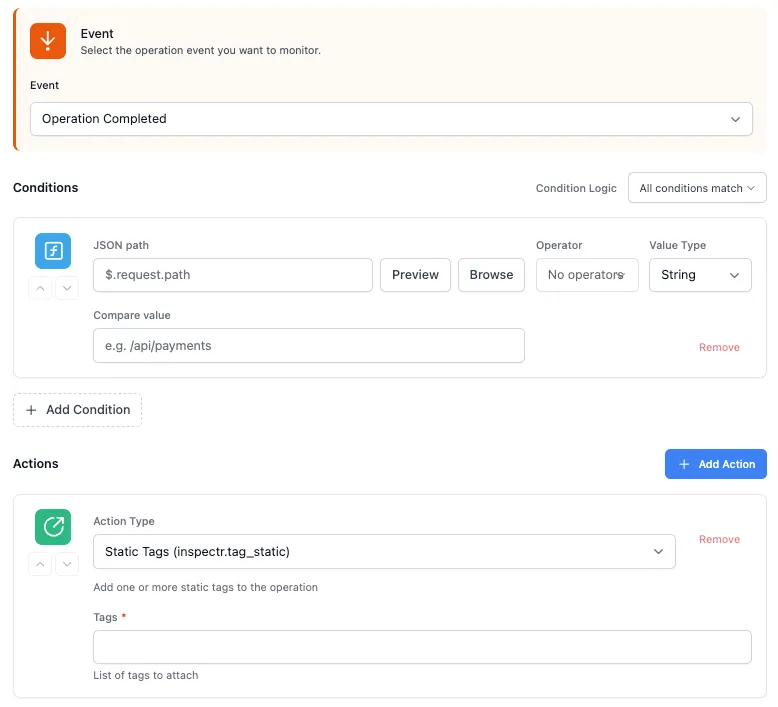
A Rule has three parts:
-
Event trigger → when the rule should run (e.g.,
operation.completed) -
Conditions → what must match (JSONPath, headers, status, latency, etc.)
-
Actions → what to do when it matches (e.g., add one or more tags)
Common use-cases:
- Tag requests by version, environment, feature flag, connector
- Mark MCP actions by tool, prompt, resource
- Group specific endpoints (e.g.,
endpoint.auth) - Label anomalies (e.g.,
ERROR: 5xx,ERROR: 405) - Add performance context (e.g.,
HTTP: performance monitoring,p95>200ms)
Configure Rules
Section titled “Configure Rules”You can create rules three ways in the UI:
1. Create from scratch
Section titled “1. Create from scratch”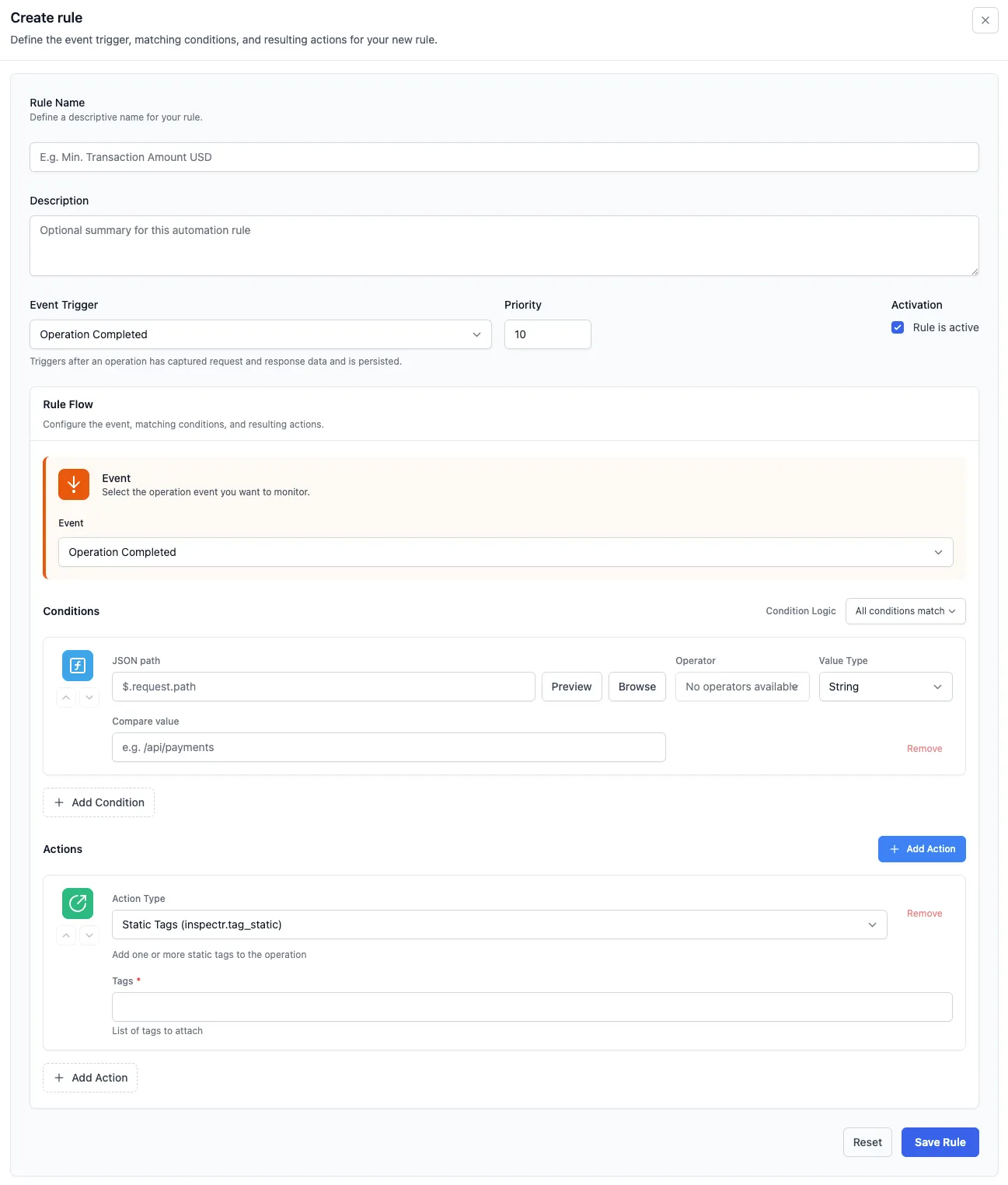
-
Go to Rules → Add rule.
-
Event Trigger: choose Operation Completed.
-
Conditions: add one or more conditions.
Example:
- Type: JSON path
- Path:
$.request.path - Compare value:
/api/versions
-
Actions: Select on of the available actions.
- Static Tags (inspectr.tag_static) → add one or more fixed tags (example:
ENV: staging,FEATURE: checkout). - Dynamic Tags (inspectr.tag_dynamic) → compute tags from the request/response (JSONPath/header extraction, templating), example:
ENDPOINT:$.request.pathorSTATUS:$.response.status. - Git Branch Tag (inspectr.tag_git_branch) → attach the current Git branch/tag/commit as a tag (great for CI runs), example:
GIT: mainorGIT: feature/x. - File Value Tag (inspectr.tag_file_value) → read a local file and tag with its content (version file, build number), example:
VERSION: 1.2.3from ./VERSION. - Remote HTTP Tag (inspectr.tag_remote_http) → call an external HTTP endpoint during rule execution and tag with its response (lookup env/tenant/feature flags), example:
TENANT_TIER: gold.
- Static Tags (inspectr.tag_static) → add one or more fixed tags (example:
-
Save.
This produces tags that will appear on each matching operation.
2. Start from a template
Section titled “2. Start from a template”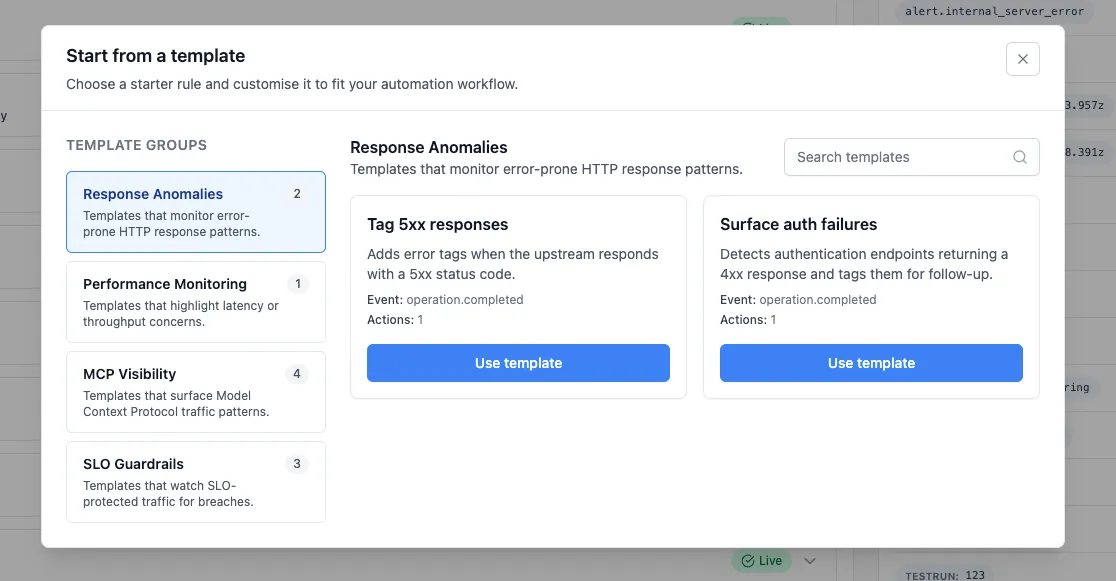
-
Rules → Start from template.
-
Pick a template, e.g.:
-
Tag 5xx responses (monitors 5xx patterns)
-
Surface auth failures (flags 4xx on auth endpoints)
-
MCP Visibility templates (classify MCP traffic by tool/prompt/resource)
-
-
Click Use template, tweak conditions/actions, save.
Templates are the fastest way to bootstrap standard monitoring and MCP visibility.
3. Import a rule (YAML)
Section titled “3. Import a rule (YAML)”
-
Rules → Import rule.
-
Paste YAML or upload a file.
-
Click Import (optionally choose Overwrite existing rules).
What the results look like
Section titled “What the results look like”Once rules are active, and you use the “tag” actions:
Request Details
Section titled “Request Details”
- Matching requests show your tags directly on the Request Details page (example:
GIT: <branch>,HTTP: performance monitoring,TESTRUN: 123,VERSION: 1.0.0).
Filter Operation History by Tags
Section titled “Filter Operation History by Tags”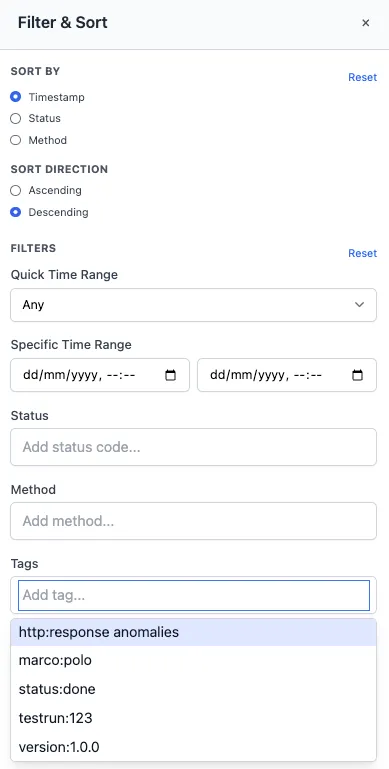
- In Request History, open Filter & Sort, add one or more tags to narrow the list (e.g.,
VERSION: 1.0.0,alert.internal_server_error, or your MCP tags).
Filter Statistics by Tags
Section titled “Filter Statistics by Tags”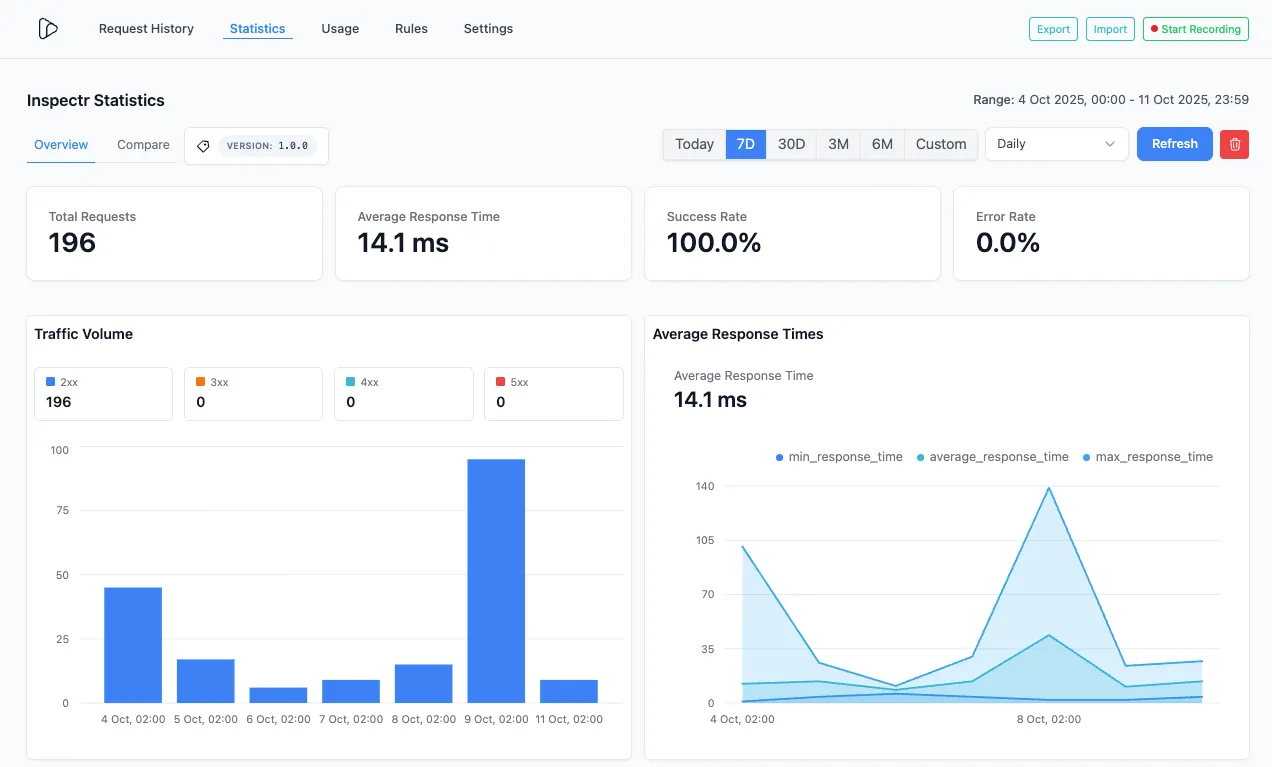
- In Statistics → Overview, select a tag to scope the dashboard (Total Requests, Avg Response Time, Success/Error rate, volume by status buckets, time series).
Compare Two Tag Statistics
Section titled “Compare Two Tag Statistics”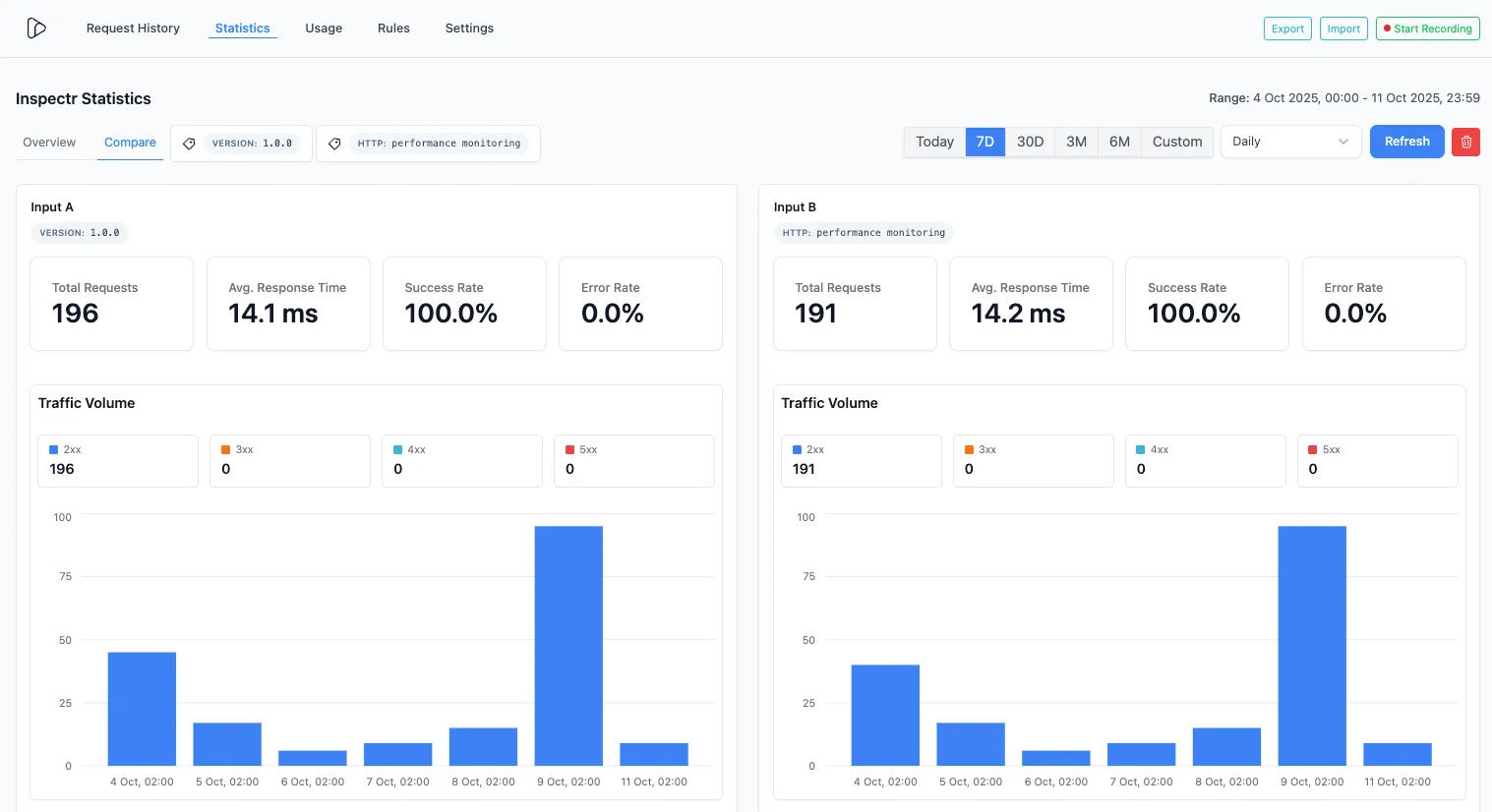
-
In Statistics → Compare, pick two tags (e.g.,
endpoint.api_versionsvsERROR: 405) and Inspectr will chart both cohorts side-by-side over the selected time range. -
Great for A/B environments (
ENV: stagingvsENV: prod), feature flags,… .
Recommended tagging conventions
Section titled “Recommended tagging conventions”Adopt consistent namespaces so you can filter quickly:
ENV: dev|staging|prodVERSION: 1.2.3(client/app version or API version)TESTRUN: <id>(suite or CI build number)FEATURE: <name>(flag/experiment)SERVICE: <name>(downstream API service)ENDPOINT: <token>(if you prefer a single tag, otherwiseendpoint.*)ERROR: 4xx|5xx|405|timeoutLATENCY: p95>200msMCP_TOOL:<tool>,MCP_PROMPT:<prompt>,RESOURCE:<id>
